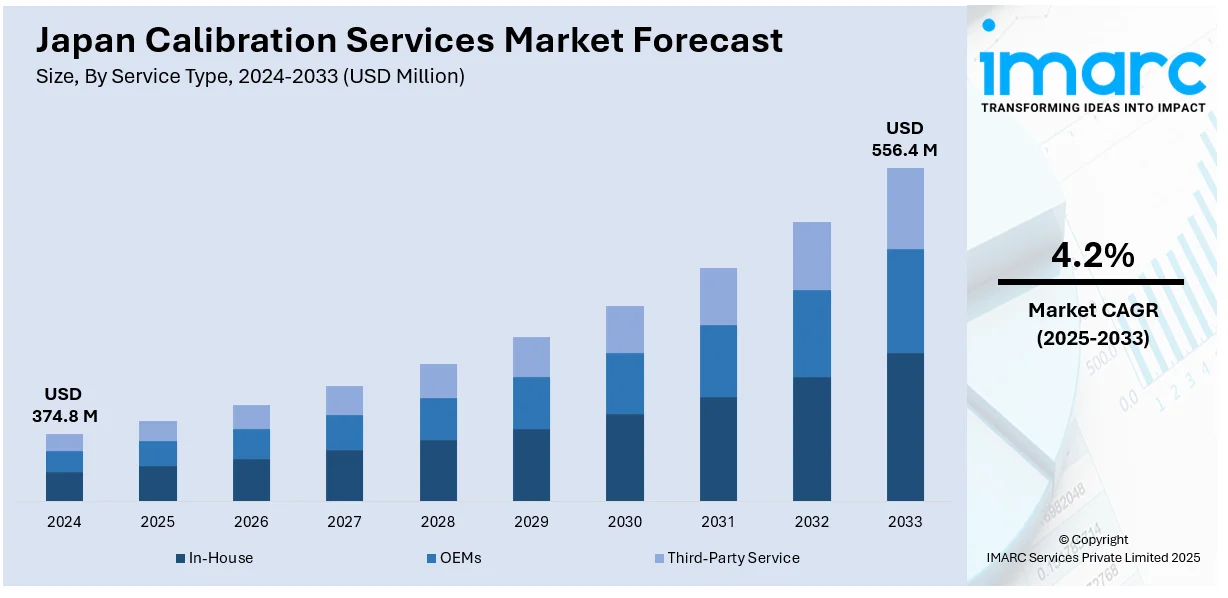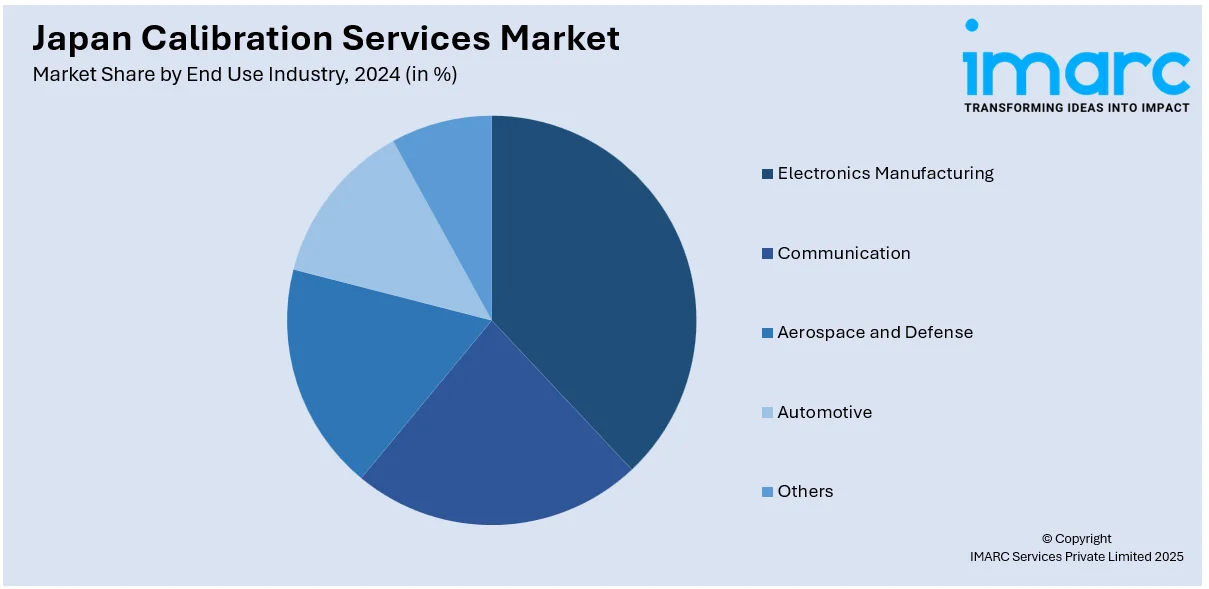
Japan Calibration Services Market Size, Share, Trends and Forecast by Service Type, Calibration Type, End Use Industry, and Region, 2025-2033
Japan Calibration Services Market Overview:
The Japan calibration services market size reached USD 374.8 Million in 2024. Looking forward, IMARC Group expects the market to reach USD 556.4 Million by 2033, exhibiting a growth rate (CAGR) of 4.2% during 2025-2033. The market is experiencing consistent growth, fueled by technological developments in industrial automation, precision manufacturing, and the need for compliance with high-quality standards. Moreover, sectors like automotive, electronics, and healthcare are driving forces, and they demand accurate calibration solutions.
|
Report Attribute
|
Key Statistics
|
|---|---|
|
Base Year
|
2024 |
|
Forecast Years
|
2025-2033
|
|
Historical Years
|
2019-2024
|
| Market Size in 2024 | USD 374.8 Million |
| Market Forecast in 2033 | USD 556.4 Million |
| Market Growth Rate 2025-2033 | 4.2% |
Japan Calibration Services Market Trends:
Rising Demand in Precision Manufacturing
Japanese precision engineering is a principal cause of calibration service growth. Japan is widely renowned for being at the cutting edge of manufacturing technology, particularly in the auto, robotics, and electronics sectors. As the sectors become increasingly dependent on computerized systems, sensors, and sophisticated equipment, the need for precise calibration to ensure accuracy and reliability increases. Calibration services are an important aspect of maintaining the performance of high-technology equipment used in production lines, assembly plants, and research laboratories. Due to Japan's industrial setup with a focus on zero-defect manufacturing, calibration services are an essential part of the process to prevent faults and downtime. For instance, automobile manufacturers are investing more in advanced systems that require frequent calibration to meet global quality standards. Japan's providers of calibration services are expanding their portfolios to deliver end-to-end solutions that cover on-site calibration, system integration, and in-house staff calibration training. More manufacturers are increasing their focus on automation and aiming to optimize the efficiency of their production, making the demand for precise and credible calibration services more likely to increase.

Technological Advancements and Compliance Requirements
Technological advancement is one of the most important drivers of Japan's calibration services sector, particularly with increased instrument and test equipment complexity. The sectors are using more complicated tools that require high-level calibration to meet particular standards. Electronic and automated calibration services have opened up faster and more accurate services, which make the calibration process more efficient. All of these technologies have been applied to meet the ever-growing needs of industries like energy, electronics, and telecommunications, where precision and accuracy are paramount. Additionally, the strict regulatory aspect of product quality, environmental standards, and quality management systems on the part of Japan is an important facilitator. Businesses are being pressed more and more to meet international standards like ISO 9001 and ISO 17025. These regulatory needs call for periodic calibration of measuring instruments and test equipment. Calibration service providers are addressing this requirement by offering tailor-made services that guarantee regulatory compliance. An evolving regulatory landscape, coupled with calibration technology advancements, is creating new opportunities for calibration service providers. As companies aim for more efficient production while being subject to strict standards, calibration services will likely be a critical component of Japan's industrial environment.
Japan Calibration Services Market Segmentation:
IMARC Group provides an analysis of the key trends in each segment of the market, along with forecasts at the country level for 2025-2033. Our report has categorized the market based on service type, calibration type, and end use industry.
Service Type Insights:
- In-House
- OEMs
- Third-Party Service
The report has provided a detailed breakup and analysis of the market based on the service type. This includes in-house, OEMs, and third-party service.
Calibration Type Insights:
- Electrical
- Mechanical
- Thermodynamic
- Physical/Dimensional
- Others
A detailed breakup and analysis of the market based on the calibration type have also been provided in the report. This includes electrical, mechanical, thermodynamic, physical/dimensional, and others.
End Use Industry Insights:

- Electronics Manufacturing
- Communication
- Aerospace and Defense
- Automotive
- Others
The report has provided a detailed breakup and analysis of the market based on the end use industry. This includes electronics manufacturing, communication, aerospace and defense, automotive, and others.
Regional Insights:
- Kanto Region
- Kansai/Kinki Region
- Central/ Chubu Region
- Kyushu-Okinawa Region
- Tohoku Region
- Chugoku Region
- Hokkaido Region
- Shikoku Region
The report has also provided a comprehensive analysis of all the major regional markets, which include Kanto Region, Kansai/Kinki Region, Central/ Chubu Region, Kyushu-Okinawa Region, Tohoku Region, Chugoku Region, Hokkaido Region, and Shikoku Region.
Competitive Landscape:
The market research report has also provided a comprehensive analysis of the competitive landscape. Competitive analysis such as market structure, key player positioning, top winning strategies, competitive dashboard, and company evaluation quadrant has been covered in the report. Also, detailed profiles of all major companies have been provided.
Japan Calibration Services Market News:
- August 2024: TOYO Corporation became the first in Japan to offer ISO/IEC 17025-accredited field probe calibration at 600 V/m, reducing turnaround time and enhancing regional access. This milestone advanced the calibration services industry by boosting efficiency in electromagnetic immunity testing for automotive electronics.
- July 2024: Renishaw opened a new technology centre in Nagoya, Japan, featuring a calibration laboratory and advanced demonstration facilities. This expansion enhanced local access to precision calibration services, supporting Japan's manufacturing sector and strengthening the calibration services sector through improved technical support and customer engagement.
Japan Calibration Services Market Report Coverage:
| Report Features | Details |
|---|---|
| Base Year of the Analysis | 2024 |
| Historical Period | 2019-2024 |
| Forecast Period | 2025-2033 |
| Units | Million USD |
| Scope of the Report |
Exploration of Historical Trends and Market Outlook, Industry Catalysts and Challenges, Segment-Wise Historical and Future Market Assessment:
|
| Service Types Covered | In-House, OEMs, Third-Party Service |
| Calibration Types Covered | Electrical, Mechanical, Thermodynamic, Physical/Dimensional, Others |
| End Use Industries Covered | Electronics Manufacturing, Communication, Aerospace and Defense, Automotive, Others |
| Regions Covered | Kanto Region, Kansai/Kinki Region, Central/ Chubu Region, Kyushu-Okinawa Region, Tohoku Region, Chugoku Region, Hokkaido Region, Shikoku Region |
| Customization Scope | 10% Free Customization |
| Post-Sale Analyst Support | 10-12 Weeks |
| Delivery Format | PDF and Excel through Email (We can also provide the editable version of the report in PPT/Word format on special request) |
Key Questions Answered in This Report:
- How has the Japan calibration services market performed so far and how will it perform in the coming years?
- What is the breakup of the Japan calibration services market on the basis of service type?
- What is the breakup of the Japan calibration services market on the basis of calibration type?
- What is the breakup of the Japan calibration services market on the basis of end use industry?
- What are the various stages in the value chain of the Japan calibration services market?
- What are the key driving factors and challenges in the Japan calibration services market?
- What is the structure of the Japan calibration services market and who are the key players?
- What is the degree of competition in the Japan calibration services market?
Key Benefits for Stakeholders:
- IMARC’s industry report offers a comprehensive quantitative analysis of various market segments, historical and current market trends, market forecasts, and dynamics of the Japan calibration services market from 2019-2033.
- The research report provides the latest information on the market drivers, challenges, and opportunities in the Japan calibration services market.
- Porter's five forces analysis assist stakeholders in assessing the impact of new entrants, competitive rivalry, supplier power, buyer power, and the threat of substitution. It helps stakeholders to analyze the level of competition within the Japan calibration services industry and its attractiveness.
- Competitive landscape allows stakeholders to understand their competitive environment and provides an insight into the current positions of key players in the market.
Need more help?
- Speak to our experienced analysts for insights on the current market scenarios.
- Include additional segments and countries to customize the report as per your requirement.
- Gain an unparalleled competitive advantage in your domain by understanding how to utilize the report and positively impacting your operations and revenue.
- For further assistance, please connect with our analysts.
 Request Customization
Request Customization
 Speak to an Analyst
Speak to an Analyst
 Request Brochure
Request Brochure
 Inquire Before Buying
Inquire Before Buying




.webp)




.webp)












